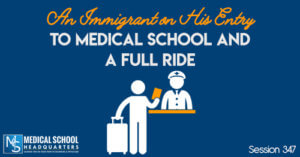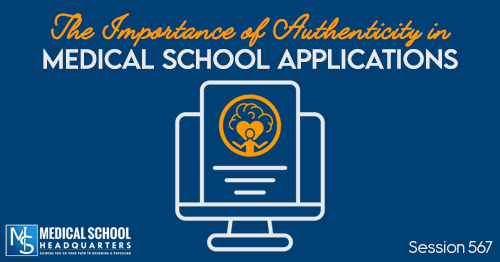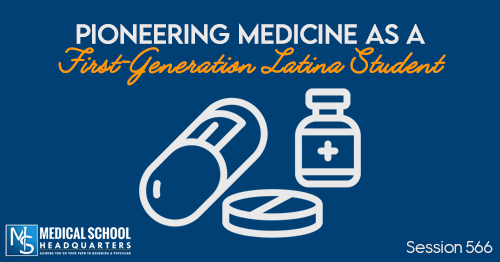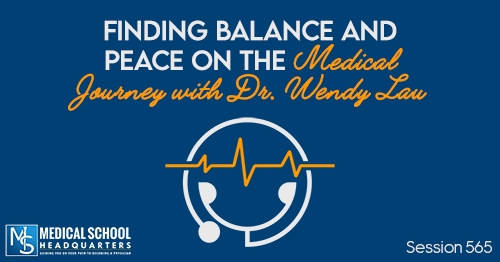Apple Podcasts | Google Podcasts

Session 347
Santiago is a first-generation immigrant. He joins me to talk about being inspired by global health, doing a postbac, and leveling the playing field for applicants. He now has an acceptance to medical school and a full ride!
If you haven’t yet, please check out all our other podcasts on Meded Media for more resources to help you along this journey to becoming a great physician!
Listen to this podcast episode with the player above, or keep reading for the highlights and takeaway points.
[01:05] Interest in Becoming a Physician as an Immigrant
Santiago has the cliche premed story where he watched a show on TV. He remembers seeing a medical procedure on the TV. But growing up, science has always stuck with him. It was also something he found he was good at in school.
So he pushed that curiosity. As he moved through high school, he was leaning more into science and up until college.
Being an immigrant, he saw this as an internal and external process of being told he could do this. Santiago feels lucky to have such a strong support system.
Along the way, there were external factors that said the opposite and being told he can’t do this. He had a career counselor coming to his seventh-grade class and when he talked about becoming a doctor, he was simply frowned upon. He was told to become a paramedic instead since it requires less training and easier to access.
At this point, he got discouraged. But his mom encouraged him further. Ultimately, he relied on the support of his family as well as his high school teachers and college friends, reemphasizing that it was possible.
[Related episode: Hear How This Immigrant Got An Acceptance to an Ivy League!]
[04:40] Transitioning from High School to College
Santiago described this as a rough phase in his life. Going into a public high school, he cruised through it and didn’t put a lot of time studying. When he got to college, he wasn’t prepared. So there was a point in his freshmen year that he was failing two classes.
He decided to withdraw one of them and had a talk with his professors. He ended up withdrawing from O Chem and focused all of his attention on Calculus to bring up his grade. Then he re-took O Chem later.
'It seemed like no matter how much I studied, there was no more time to put into study so I had to switch how I studied.'Click To TweetBack in high school, he wasn’t used to long-term studying and realized that the short window of studying would never be enough.
What led him to realize he had to change his studying style was that moment when he wasn’t going to salvage both grades.
Luckily, the university he went to had an academic advising center where he could ask for advice. They helped through the process of talking with professors and choosing which one to withdraw from and which one to focus on.
In high school, tutoring has a negative stereotype to it. It’s like if you need tutoring, you’re not smart. So he had to come to a realization that asking for help doesn’t mean you’re dumb.
And this mindset has helped him throughout the long run. When you’ve reached the limits of what you can do, be able to ask for help from experts or people that know what they’re talking about.
[08:40] Passion for Global Health and Taking Summer Classes
Santiago intended to start out with a major in Biology. But as soon as he got to a Biology lab, he found that he hated it. He realized it wasn’t what he wanted to do. He ended up stumbling upon global health, where he found the passion for a cross between academic interest and his Latino influence.
Struggling with O. Chem, he initially had doubts even all the way up to when he got to medical school. His strategy was to take O. Chem in the summer by itself so he can only focus on it. And he did the same with Physics 2, taking it up in the summer so he can solely focus on just that class.
'Most of the learning that you do comes outside of class, not during the lecture.'Click To TweetSantiago believes that most of the learning is outside the lecture. During lecture, you’re only being presented the material for the first time. It’s when you really go back and digest the material, where you get to compare notes or create a study guide for the exam. To him, this is where real learning takes place.
[Related episode: The Pros and Cons of Global Healthcare Experiences]
[14:20] The Biggest Source of Doubt and Taking a Postbac Program
Santiago’s biggest source of doubt is with is academics. He only shadowed one physician and he didn’t really know how medical schools were going to look at it. He also knew that after postbac, his science GPA was a 3.1 from a 2.9, basically borderline. This was his biggest form of doubt. But he also knew this was something that can be improved even if it takes another year.
After speaking with a premed advisor. she was honest to tell him that his grades won’t get him to medical school. But he knew she was right. There were grades that needed fixing. So he worked on it a year after undergrad and looked at some of the postbac programs in the area. And it worked!
'I'm a strong believer in postbacs, it's just the financial toll of postbacs is something that has to be considered.'Click To TweetSantiago took a formal postbac program, designed for both academic boosters and career-changers. They had predetermined the number of courses students were supposed to take per semester. With only three classes per semester, he also had enough time to pursue other things to strengthen his application.
At this time, Santiago worked as an EMT so he used this chunk of time for it. Although he also shadowed the same physician throughout his postbac year.
He chose to take a formal postbac since he was able to get financial aid. The rest of it was taken out through a loan. So even though the cost was initially high, he saw it could be something he could bulk with his really low undergrad loans.
[Related episode: How Should I Prepare for my Postbac Interview?]
[18:40 Taking the MCAT as an ESL Student
With English as his secondary language, Santiago admits having always struggled with standardized tests. But he came to the United States when he was four years old, so he has spent the majority of his life in the U.S., so the language barrier was out of the way.
What he really struggled with more was not having the guidance of someone who had been through it before. So he sought guidance from his friends who were ahead of him and used them as a resource. They also helped him look at his essays and his applications.
It took him quite a chunk of time between undergrad and applying because he had to find a job. He worked for the cancer institute of the college he went to. He worked on some Global Health research on smoking cessation of pregnant women. During this time, he got EMT-trained and he wanted to use the license so he then got a job doing non-emergency medical transport.
On the second year, he took the postbac. This pushed him taking the MCAT further until after the postbac. This has put him in the application cycle during his third year out from undergrad.
Santiago was mindful that he was doing stuff not just because he could check off boxes. What has motivated him to pursue medicine is learning skills. The first time he learned CPR blew him away. And this motivated him to learn EMT. Then he got phlebotomy training and now working in the emergency department at a level 1 trauma center.
[22:45] The Biggest Hurdle Among the Latino Community
One of Santiago’s hurdles is not having a clear path. You just see things in a different lens and working in a clinical environment, you see that Latino patients are treated or the language barrier that exists in the healthcare field. The need for a translator can really slow down medical care. And this has been one of the most eye-opening things for him.
He knew that if there was a physician that was fluent in Spanish, that patient would feel so much more comfortable. Their medical information can be taken so much quicker than having to wait for the translator to come.
[24:00] Choosing Which Schools to Apply To and The Need for Travel Aid
Santiago’s choice was more limited to geography due to the finances. Coming from a high-ranking university, he knew that he could overcome whatever challenge. So he looked at what’s around him and what he can drive to if he can’t find a cheap flight.
'Those $30-$50 of each school can add up really quickly. And the financial cost of traveling is very expensive if you consider flying.'Click To TweetSantiago thinks that if you have family members who are physicians, it’s so much easier to shadow or for them to find you some research opportunities. And if you’re financially dependent on your parents, you can have more free time to volunteer or shadow. This is not the case though for applicants who are working to pay rent.
He wished he could tell admissions committees that if they’re really serious about increasing representation from racial, ethnic, and financial minorities, then they need to increase the amount of travel aid for applicants from these backgrounds.
Santiago did apply for the Fee Assistance Program (FAP), which was a great help for the MCAT. It did reduce the cost and that’s how he got the fee waivers for the secondaries. The MCAT bundle they included through the AAMC was helpful.
But he really had to use exclusively free and reduced-cost options to study for the MCAT. That said, he utilized podcasts including The Premed Years, Khan Academy, as well as every sample test material from every test prep company. He used the website that gave the syllabus of what will be on the MCAT (MCATSelfPrep.com)
For reduced cost, he focused on everything the FAP brings. He bought the bundle with the four full-length AAMC exams, which for him was the most helpful thing he used.
[30:23] Studying for the MCAT
Santiago had a few “starts” to study. Six months out, he tried to do it during his free time. This didn’t work. Three months out, he started designating three hours a day and treated it like a class.
As soon as his postbac was over, he had just under a month until the test date. He completely shut himself off from the world. He stopped working and going outside much. He started studying 10-14 hours a day. This was a miserable process for him that’s why he doesn’t recommend this to anyone.
But this worked for him though only taking the MCAT just once. He knew where he stood just before the test day based on the AAMC full-length exams. He ended up scoring a point from what he scored in his last practice exam.
'AAMC's full-length exams are really accurate and really close to what the real MCAT is.'Click To TweetBased on his experience, he told the next cohort of the postbac to study as early as possible. He also tried to design a long-term test prep program for them.
[Related episode: How to Best Use Flashcards to Study for the MCAT]
[32:18] The Hardest Part of the Application Process
For Santiago, the hardest part of the application process was picking up the secondaries right after taking the MCAT. There was a significant gap since he felt so drained after the MCAT.
He felt he didn’t write the secondaries as much as he should have. The last secondary he turned in wasn’t until late September. And he felt this hurt him in his admission cycle that he didn’t get an interview from that school.
'Students need to understand the whole rolling admissions process.'Click To TweetBe sure to prewrite your secondaries and to turn your applications in as soon as possible. Take the MCAT as early as possible so everything is in and done and ready to go.
[33:35] Preparing for the Interview Process
Santiago found SDN to be helpful in preparing for his interview. People who went to these different interviews posted the interview questions they were asked.
He also read The Premed Playbook: Guide to the Medical School Interview, which he found very helpful for learning from case studies. It was great to learn from how previous applicants messed up and then how they have been coached through to fix their stories.
The hardest question he got was what he would do if he couldn’t be a doctor. He had prepared for this and this has come up as a tough interview question in many resources. So he felt prepared to answer it.
His answer was to pursue Global Health and paramedics. He would get more clinical skills and apply it internationally.
'I would still do the same role of providing medical care internationally, in the global health aspect, just not as a physician.'Click To Tweet[35:20] Getting the Acceptance and What’s Next for Him
Being awarded scholarship money to go to medical school was a huge blessing for Santiago. In schools that earned him acceptance, he took advantage of their financial aid section. He got to explain his financial situation.
For now, what’s next for him is to go on a vacation before starting medical school. He’s getting housing set up in the city he’s living. He is also pursuing an MD/MPH at one of the best public health schools in the country. He also plans on continuing to do his research on immigrant health.
The school he’s going to has a pass/fail system so he thinks this takes a bit of the pressure off.
'Thankfully, it's pass/fail at the school I'm going to so I feel that takes a little bit of the pressure off.'Click To Tweet[37:32] Final Words of Wisdom to Other Premeds
Just realize that the cards are stacked against you as an immigrant or as someone coming from lower socio-economic backgrounds.
'You have to prepare earlier and harder than most other applicants. The only way you can do that is through knowledge.'Click To TweetAs early as you are in your premed or application cycle, be aware of what that process might look like. Reach out to people that have gone through it. Try to get connected with a community of students that have fone through that process. Just start studying as soon as you can.
To those pondering on doing a postbac and wondering if this is still the right path for them, Santiago’s advice to these students is to be realistic when looking at their application.
Work on the weakest areas of your application even as you’re applying, before you’re reapplying, or when you’re reapplying. Take a good look on what you can improve and what you can focus on.
And if you do get rejected by schools, follow with them. Most of them are willing to tell you how they look at your application or what they’ve seen that may have discouraged them from offering you a seat in their class.
[39:45] Seeking Out a Mentor
One of the biggest regrets Santiago had back in undergrad was not having a mentor in the field he was looking to get into – not a physician or medical student that had gone through the process before.
You need to get that information early and straight from someone that has successfully gone through the process. One of the ways you can do this is being part of the cultural groups on campus. It can be tough to seek out for mentorship. But don’t be scared to ask for help. That information is available if you just ask.
'Don't be scared to ask for help. It doesn't mean you're worth any less. It just means you don't have the resources currently to get to where you need to be.' Click To Tweet










